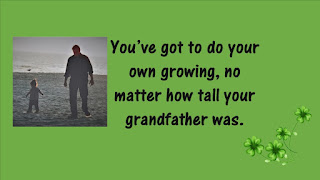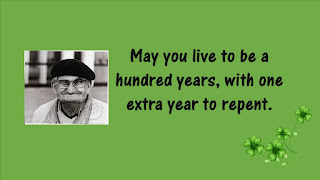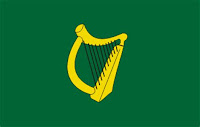I’ve always embraced my Celtic roots, from the auburn in my hair to my Irish smile. Movies about Ireland are among my favorites. The Quiet Man with John Wayne and Maureen O’Hara, and Leap Year, a contemporary love story. Yes, Ireland has always been deep in my soul, until my sister took a DNA test and found we’d spent more time in other European countries than the Emerald Isle.
At any rate, here's the craic on some misunderstood Irish facts. (Craic is a common word for fun going's on, gossip, or story.)
First off, let’s talk about Saint Patrick, the patron saint of Ireland. He wasn’t Irish. He was but a lad of about sixteen and a Roman citizen of Britain, when he was captured by pirates and sold into slavery in Ireland. He escaped to his homeland, became an ordained Bishop, and returned to the land of his captivity as a missionary. Some say he drove the snakes (the pagans) out of Ireland, but more accurately, Saint Patrick brought Christianity into the country. As a result, he was instrumental in changing laws and culture, advocating for women, the poor, and the enslaved.
Do you know what the national symbol is? The shamrock, you say. Indeed, ‘tis not! Well, not the only one, anyway. A 14th century harp is the official national emblem of Ireland, but not without its controversy. As respected as poets, harpers were held in high esteem. In 1431, Henry the VIII of England declared the musical instrument as the national symbol. He even ordered the image to be used on coins. Eventually, however, harp music fell out of favor. By 1912, the harp was resurrected as a representation of resistance to the United Kingdom, and the image was flown on a green flag. After gaining their independence, the Irish government wished to make it their national symbol once more. But not so fast! Guinness, as in the beer, had already registered the figure in 1862, long before the revolution. Not to be deterred, the government simply flipped the harp from left to right, effectively distinguishing the harp’s image for posterity.
 |
| Picture is of my husband and our granddaughter, Sophia. |
If you ask an Irishman a direct question, they will not answer with a simple “yes” or “no.” This is because these words are not in their original Gaelic vocabulary that dates back to the 4th century. When you inquire if they want to join you at the pub, they will answer with “I would” or “I would not.” More than likely the former as many of them love their beer—the one with the harp on it.
The drop of Irish blood in me wishes to bestow a blessing before we part:
MissAdventure Brides Collection
Seven daring damsels don’t let the norms of their eras hold them back. Along the way these women attract the attention of men who admire their bravery and determination, but will they let love grow out of the adventures? Includes:
"Riders of the Painted Star" by Kathleen E. Kovach
1936 Arizona
Zadie Fitzpatrick, an artist from New York, is commissioned to go on location in Arizona to paint illustrations for an author of western novels and falls for the male model.
Kathleen E. Kovach is a Christian romance author published traditionally through Barbour Publishing, Inc. as well as indie. Kathleen and her husband, Jim, raised two sons while living the nomadic lifestyle for over twenty years in the Air Force. Now planted in northeast Colorado, she's a grandmother, though much too young for that. Kathleen is a longstanding member of American Christian Fiction Writers. An award-winning author, she presents spiritual truths with a giggle, proving herself as one of God's peculiar people.











Great post! Thanks for sharing. The same thing happened to my husband. The family always talked about their Irish roots, then after some genealogy studies discovered they are actually more Welsh than Irish. Oops!
ReplyDeleteThis was fin for me. I was born a Mullvain and married a Mulligan. I'm Irish through and through, although there a tiny bit of French sprinkled in there.
ReplyDeleteI am Scot-Irish and love this. The saying are hilarious.
ReplyDeleteThanks for posting. I have always loved hearing about the Irish. I've read many novels written by and about them. So I loved this! The sayings are so funny.
ReplyDeleteMy sister and I did DNA test. Turns out I'm more Irish than her, you may have more than your sister. I grew up with a Scottish name and knew it was Scottish, but as I became older I was drawn more to everything English. Turns out I am much more English than Scottish.
ReplyDeleteKathy, although I have known for years I have a lot of English in me. More than German although my surname is German. Then my DNA revealed I have about 28% Irish in me with a bit of Scottish mixed in. Say what??? Yes, a lot of me is connected to England and only a small bit is German. My G-G-grandfather came from Germany in his mom's arms as a 6-month old. And the Meyer name was passed down from him. (my paternal grandparents added the "s" during WWI to make it sound less German.) But as they say, on St. Patrick's day everyone is Irish. LOL. Earlier this month, I gave a presentation to the museum in Lake Geneva, WI, the town I grew up in, which is the setting for my historicals. The topic was about an enclave of Irish immigrants who settled just west of town back in the 19th Century. If you want to know more about Irish Woods, search my articles on this blog for "Irish Woods." Thanks for reminding many of us that no matter what our blood says, we are all Irish on St. Paddy's Day!
ReplyDelete